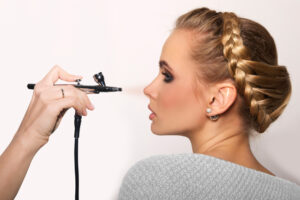There are many reasons to consider airbrush makeup. Perhaps your clients have been asking about it, or some could benefit from a longer-lasting option. You may also just be interested in trying a new technique yourself. Whatever the case, knowing the best practices for applying airbrush makeup can help you create stunning looks. Some tips include:
Hydrate the Skin First
Hydrating the skin is a best practice for makeup application in general. It helps protect the skin, especially in patients with dry skin. Remember, airbrush makeup stays on the face longer, so clients likely won’t be rinsing it off for many hours. Consider using a hydrating toner and hydrating moisturizer.
Apply Primer
Although the airbrush technique already helps makeup stay in place, primer can ensure it stays put longer. Clients will appreciate how long they maintain the flawless look on a special day out.
Follow Circular Motions
Over-spraying is a common mistake with airbrush makeup. To avoid this, move the airbrush in a circular motion. This technique can also prevent you from ending an airbrush motion directly over the skin, which may result in a patch of makeup. Circular motions ensure even coverage.
Another cause of uneven applications is getting too close to the skin. Keep the airbrush gun at a safe distance from the skin, and never let it directly touch the skin.
Choose the Right Airflow Setting
Most airbrush guns will feature several airflow settings. Each setting is appropriate for different types of makeup applications. General settings include:
- Light air for detail work and correcting spots
- Medium air for everyday application of foundation and blush
- Full air for highlighter and other areas of the body (arms)
Blend Makeup Into the Neck
Don’t forget the neck when applying airbrush makeup. Not blending makeup creates lines and an unnatural look. You may use traditional makeup tools for blending.
Use Airbrush Makeup for All Applications
Typically, airbrush makeup is for applying foundation. However, it can be used to apply other kinds of makeup, including:
- Blush
- Eyeshadow
- Eyebrows
- Highlight
- Bronzer



